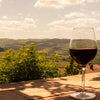Unlocking the Art of Wine Tasting: A Beginner’s Guide
- by David Bentley
Many people perceive wine tasting as an exclusive, complex ritual reserved for sommeliers and connoisseurs. The truth? Anyone who enjoys wine can appreciate and explore its nuances with just a little guidance. Whether you're sipping at a vineyard, attending a wine tasting event, or simply enjoying a glass at home, understanding a few key principles can elevate your experience.
Setting the Stage for Wine Tasting
Before you even take your first sip, setting the right environment is crucial. A few simple yet effective rules can enhance your ability to detect the aromas and flavours of a wine:
- Avoid strong scents: Tasting wine in a room filled with smoke or heavy perfume can interfere with your senses.
- Watch what you consume beforehand: Avoid toothpaste, mints, coffee, or strongly flavoured foods right before tasting, as they can alter your palate.
- Spit or sip?: While you don’t have to spit out the wine, doing so allows you to taste more varieties with a clear head.
-
Follow a logical tasting order: Start with whites before reds, dry before sweet, and light-bodied wines before heavier ones. If you're tasting fortified wines or spirits, save them for last. Checking the alcohol content on the label can also guide your sequence.
The Three Essential Stages of Wine Tasting
To fully appreciate a wine, follow these three steps: visual examination, aroma assessment, and tasting.
1. The Visual Examination
Begin by observing the colour and clarity of the wine. Tilt your glass at a 45-degree angle and examine both the centre and the rim. The hue can offer insights into the wine’s age and character:
- White wines tend to deepen in colour over time, from pale straw to rich golden tones.
-
Red wines do the opposite, losing colour and shifting from deep purple to brick-red or orange-brown hues.
2. Evaluating the Aroma (Bouquet)
Aroma is a key element of wine tasting, offering clues about grape variety, winemaking techniques, and even ageing processes. Swirl your glass gently to release the wine’s bouquet, then take a deep sniff. You might detect notes from a variety of categories:
- Floral: Acacia, almond blossom, honeysuckle, elderflower, rose
- Fresh fruit: Apricots, bananas, pineapple, raspberry, grapefruit
- Dried fruit: Almonds, raisins, figs, prunes
- Spices: Cinnamon, cloves, ginger, nutmeg, bay leaf
- Vegetal: Fresh grass, pine, mushrooms, cigar box
- Confectionery: Vanilla, aniseed, caramel, liquorice
- Burnt aromas: Toasted wood, coffee, cocoa, tar
- Animal aromas: Leather, game, musk
-
Faulty notes (bad signs): Musty, vinegary, stalky, cabbage-like odours
3. The Taste Test
Now, the moment of truth! Take a sip, ensuring you draw in some air as well, and let the wine coat your palate. Notice the initial sensation, the evolution of flavours, and finally, the finish.
Ask yourself:
- What are the dominant flavours?
- Does the wine feel balanced between sweetness, acidity, tannins, and alcohol?
- How long does the flavour linger after swallowing?
- Most importantly—do you like it?
Make Wine Tasting Personal
When describing wine, use terms that make sense to you. Writing down your impressions can help you refine your preferences and make better wine choices in the future. Ultimately, wine tasting should be an enjoyable and enriching experience—one that deepens your appreciation for every glass you pour.
So, next time you uncork a bottle, take a moment to observe, swirl, sniff, and savour. Cheers to discovering the wonderful world of wine!





